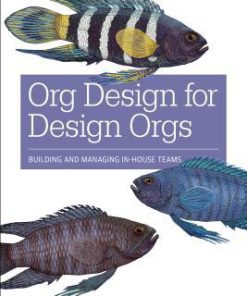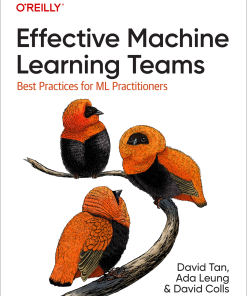Agile Leadership Toolkit Learning to Thrive with Self Managing Teams 1st Edition by Peter Koning ISBN 0135224969 978-0135224960
$50.00 Original price was: $50.00.$25.00Current price is: $25.00.
Agile Leadership Toolkit Learning to Thrive with Self Managing Teams 1st Edition by Peter Koning – Ebook PDF Instant Download/Delivery: 0135224969, 978-0135224960
Full download Agile Leadership Toolkit Learning to Thrive with Self Managing Teams 1st Edition after payment

Product details:
ISBN 10: 0135224969
ISBN 13: 978-0135224960
Author: Peter Koning
If you lead in organizations that have adopted agile methods, you know it’s crucial to create the right environment for your agile teams. Traditional tools such as Gantt charts, detailed plans, and internal KPIs aren’t adequate for complex and fast-changing markets, but merely trusting participants and teams to self-manage isn’t sufficient, either. In Agile Leadership Toolkit, long-time agile leader Peter Koning provides an invaluable steering wheel for agile leaders and their teams.
Drawing on his extensive experience helping leaders drive more value from agile, Koning offers a comprehensive toolkit for continuously improving your environment, including structures, metrics, meeting techniques, and governance for creating thriving teams that build disruptive products and services. Koning thoughtfully explains how to lead agile teams at the large scale, and how team members fit into both the team and the wider organization
Table of contents:
Part 1: Co-Create Goals
1.1 How Do You Set the Right Goals?
Traditional versus New Goals
Tool 1: Key Value Indicator
1.2 How Do You Find the Right KVIs?
What Is a Good KVI?
In Three Steps to a First KVI
How Do I Know We Have an Inspiring KVI?
The 5×1 for Inspirational KVIs
Pitfalls When Choosing and Using KVIs
How Do I Give Inspiring Goals?
1.3 How to Visualize the Customer Impact?
Complex Customer Impact
Tool 2: Impact Ladder
Summary of Part 1—Co-Create Goals
The Agile Leader as a Co-Creator of Inspiring Goals
Concrete Actions
Part 2: Facilitate Ownership
2.1 When Do Teams Take Ownership?
What Is Ownership?
Why Ownership?
How Do Teams Deal with Ownership?
The Agile Leader as a Facilitator
2.2 When Is Intervening the Best Strategy, and When Is Letting Go Better?
Tool 3: Ownership Model
Horizontal Axis: Maturity on Achieving Goals
Vertical Axis: Freedom
Two Bad Zones
Good Zone
Staircase
2.3 How Mature Is My Team?
Stages in Maturity
Other Indicators
2.4 How Do Typical Teams Grow?
Stage 0: Start
Stage 1: Output
Stage 2: Quality
Stage 3: Scaling
Stage 4: Impact
After That?
2.5 How Can the Borders Be Aligned with the Maturity?
Concretely Expanding the Borders
Tool 4: Freedom Matrix
2.6 When Does the Ownership Model Work and When Does It Not?
Teams Need a Single Concrete, Shared Goal
Teams Should Be Able to Give Open Feedback to the Leader to Maintain Ownership
Teams Need to Focus on Working Smarter
Quick Customer Appreciation
Agile Leaders Need to Escape the Yearly Employee Feedback Ritual
Resilience
Summary of Part 2—Facilitate Ownership
The Agile Leader’s Responsibility to Facilitate Ownership in His Team(s)
Tangible Actions
Part 3: Learn Faster
3.1 How Do You Know Your Teams Are Doing the Right Things?
Control Over Activities
What Is the Learning Loop?
The Agile Leader as an Experimenter
3.2 How Quickly Do My Teams Learn from Users?
Tool 5: T2L
Higher Agility through Shorter T2L
T2L in Practice
Four Additional Benefits of a Better T2L
3.3 How Can the Learning Loop Be Put into Practice?
Tool 6: VLB
The Card on the Board
How Detailed Should the VLB Be?
Common Place, Close to the Team
Stakeholders and Customers Meeting
Power of the Validated Learning Board
3.4 How Can Teams Implement Big Ideas in Small Steps?
Split into Target Group and Situations, Not into Parts and Functionality
Pitfalls When Shortening the T2L
3.5 Minimize the Blast Radius
If All Changes Are Successful, Insufficient Innovation Will Take Place
Summary of Part 3—Learn Faster
The Agile Leader as an Experimenter
Concrete Actions
Part 4: Design Healthy Habits
4.1 How Do You Stimulate an Agile Culture?
How Do You Improve the Culture?
What Is an Agile Culture?
Why Did the Existing Habits Block the New Culture?
What Are Habits?
How Do Habits Change?
4.2 How Do You Design Healthy Habits?
Healthy and Unhealthy Habits
Tool 7: Habit Matrix
Recognizing Underlying Habits—Two Examples
Role of the Agile Leader
4.3 Can You Anchor the Cultural Improvement?
Who Are the Heroes of an Agile Culture?
A Few People Define the Culture for Many
How Do You Anchor the Cultural Improvement?
4.4 What Is a Healthy Habit to Implement Improvements?
Enabling Improvements
Tool 8: TO-GRIP
Summary of Part 4—Design Healthy Habits
The Agile Leader as Culture Leader
Concrete Questions
After Reading This Book
Why a New Toolkit?
Agile Leadership Toolkit
People also search for:
agile leadership toolkit book pdf
agile leadership toolkit peter koning
agile leadership examples
what is agile leadership
agile leadership toolkit learning to thrive with self-managing teams
Tags:
Peter Koning,Agile Leadership Toolkit,Thrive,Self Managing Teams
You may also like…
Computers - Programming
Deep Reinforcement Learning in Unity With Unity ML Toolkit 1st Edition Abhilash Majumder
Uncategorized
The Async First Playbook Remote Collaboration Techniques for Agile Software Teams 1st Edition Moghe
Computers - Web Development
Lean UX Designing Great Products with Agile Teams 2nd Edition Jeff Gothelf
Business & Economics - Management & Leadership
Liftoff Start and Sustain Successful Agile Teams 2nd Edition Diana Larsen 9781680501636, 1680501631
Art photography
Business & Economics
Computers - Programming
Business & Economics - Management & Leadership
Uncategorized












